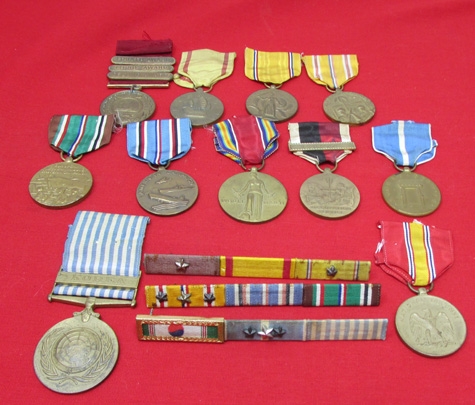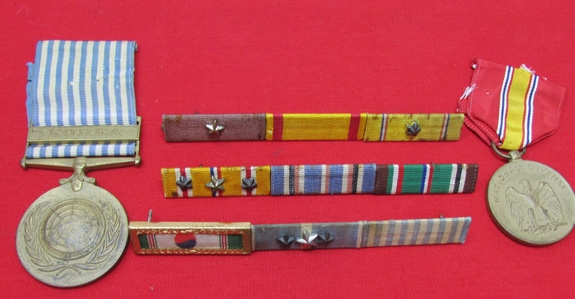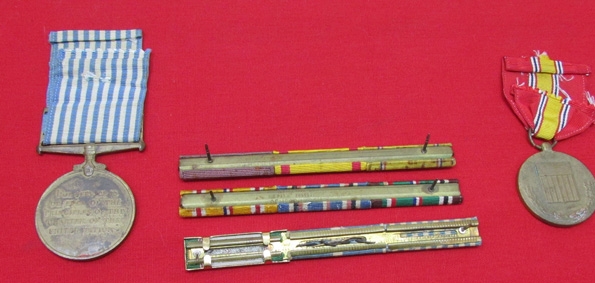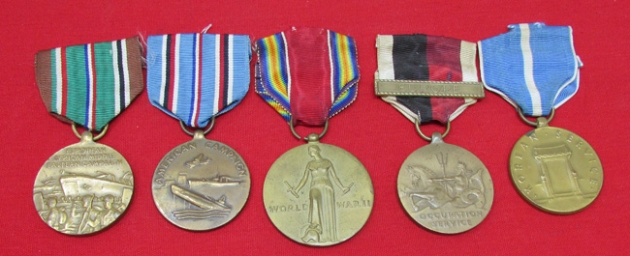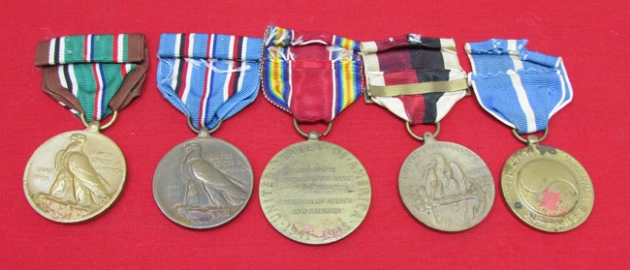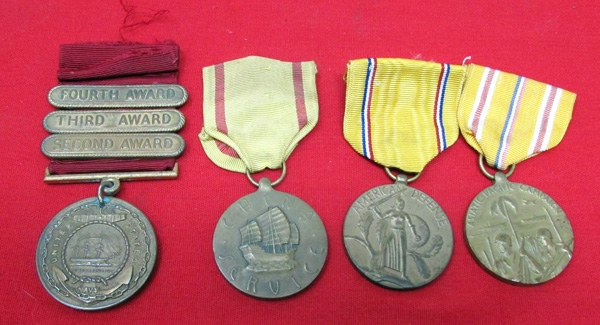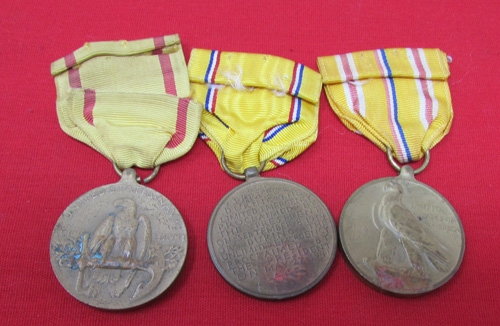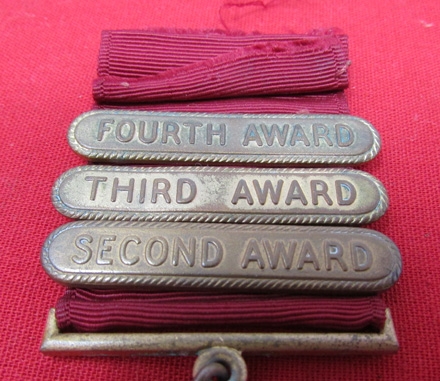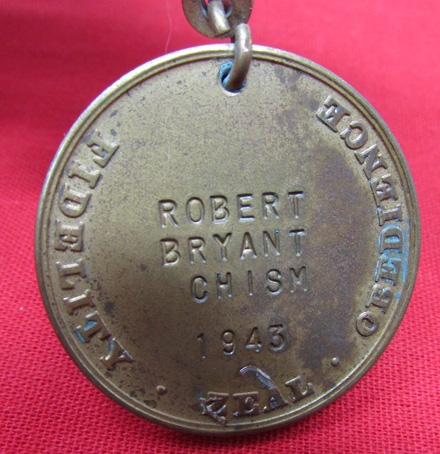US WWII-Korean War, Named US Navy Grouping, USS Lexington Sinking Survivor, Battle of the Coral Sea 1942
This item is listed for historical interest only. It was listed on our site previously but has
been sold and is no longer available for purchase.
Sold for: $295.00
US WWII-Korean War, Named US Navy Grouping, USS Lexington Sinking Survivor, Battle of the Coral Sea 1942
This item is listed for historical interest only. It was listed on our site previously but has
been sold and is no longer available for purchase.
Sold for: $295.00
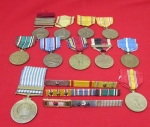 Original era manufacture. US WWII, Korean War US Navy named medal grouping. 11 medals and three, 3 place ribbon bars.All of the medals were awarded to Robert Bryant Chism, 337 31 93, who served aboard the following ships during his service time; USS Lexington, USS Alabama, USS Antietam and USS Rochester. All of the medals appear to have their original ribbons, they also display evidence of being mounted to medal bars for wear.In addition for the Korean Campaign medal, Chism was awarded the ETO & Asiatic-Pacific Campaign medals for WWII. Chism served aboard the aircraft carrier USS Lexington (CV-2) from September 1940, and was a member of her crew when the Lexington was sunk, after being hit with two Japanese aerial bombs and torpedoes, during the Battle of the Coral Sea in May 1942.In July 1942 he was assigned to the newly commissioned USS Alabama. He served aboard the Alabama until transferred to the USS Antietam in June 1945, and then on to the USS Rochester in 1947. (*Please note, the Ancestry Navy Muster Rolls, concerning Chism show him serving on both USS Lexington's, CV-2 & CV-16, I believe this to be an input error, as CV-16 (USS Cabot) was not renamed Lexington until after the original Lexington was sunk in May 1942. The muster roll for Chism dated 20 July 1942, shows him as transferred to BB-60, the USS Alabama, from the Lexington.) The USS Alabama served for a time assigned to the British Home Fleet in early 1943; while in British service, the Alabama participated in Operation Governor, which was an unsuccessful attempt to lure the German battleship Tirpitz from her Norwegian lair.Transferred to the US Pacific Fleet in the summer of 1943, the Alabama arrived at the New Hebrides islands in September 1943, participating in the shore bombardment during the Tarawa & Betio landings. Further service in the Pacific Theater included bombardment and fleet support during the following operations; Tinian, Saipan, Guam, Ponape. During the Battle of the Philippine Sea, 19 June 1944, her Radar was the first to alert the US Fleet of large formations of incoming Japanese aircraft. Her early warning allowed the US carriers to deploy clouds of US Navy fighters; resulting in the Marianas Turkey Shoot, when over 400 enemy aircraft were destroyed in the air.Chism transferred to the aircraft carrier USS Antietam (CV-36) in June 1945, she served for three years in the Far East, arriving in Shanghai China on 2nd September 1945. April 1947 found Chism assigned to the cruiser USS Rochester (CA-124). The Rochester, along with the British cruiser HMS Jamaica, were attacked by a North Korean marked (perhaps Russian piloted) Il-2 Sturmovik aircraft on 17 September 1950. The Sturmovik dropped four bombs near the Rochester, with one striking the ships crane but failed to explode. The aircraft next strafed the Jamaica killing a sailor and wounding several others; it crashed into the sea after being hit with defensive fire from the British ship. Later, the crew of the Rochester painted a Purple Heart on the crane to commemorate the incident and close call of their ship during the attack. This was the only recorded incident of an aerial attack on Naval forces during the Korean War.
Original era manufacture. US WWII, Korean War US Navy named medal grouping. 11 medals and three, 3 place ribbon bars.All of the medals were awarded to Robert Bryant Chism, 337 31 93, who served aboard the following ships during his service time; USS Lexington, USS Alabama, USS Antietam and USS Rochester. All of the medals appear to have their original ribbons, they also display evidence of being mounted to medal bars for wear.In addition for the Korean Campaign medal, Chism was awarded the ETO & Asiatic-Pacific Campaign medals for WWII. Chism served aboard the aircraft carrier USS Lexington (CV-2) from September 1940, and was a member of her crew when the Lexington was sunk, after being hit with two Japanese aerial bombs and torpedoes, during the Battle of the Coral Sea in May 1942.In July 1942 he was assigned to the newly commissioned USS Alabama. He served aboard the Alabama until transferred to the USS Antietam in June 1945, and then on to the USS Rochester in 1947. (*Please note, the Ancestry Navy Muster Rolls, concerning Chism show him serving on both USS Lexington's, CV-2 & CV-16, I believe this to be an input error, as CV-16 (USS Cabot) was not renamed Lexington until after the original Lexington was sunk in May 1942. The muster roll for Chism dated 20 July 1942, shows him as transferred to BB-60, the USS Alabama, from the Lexington.) The USS Alabama served for a time assigned to the British Home Fleet in early 1943; while in British service, the Alabama participated in Operation Governor, which was an unsuccessful attempt to lure the German battleship Tirpitz from her Norwegian lair.Transferred to the US Pacific Fleet in the summer of 1943, the Alabama arrived at the New Hebrides islands in September 1943, participating in the shore bombardment during the Tarawa & Betio landings. Further service in the Pacific Theater included bombardment and fleet support during the following operations; Tinian, Saipan, Guam, Ponape. During the Battle of the Philippine Sea, 19 June 1944, her Radar was the first to alert the US Fleet of large formations of incoming Japanese aircraft. Her early warning allowed the US carriers to deploy clouds of US Navy fighters; resulting in the Marianas Turkey Shoot, when over 400 enemy aircraft were destroyed in the air.Chism transferred to the aircraft carrier USS Antietam (CV-36) in June 1945, she served for three years in the Far East, arriving in Shanghai China on 2nd September 1945. April 1947 found Chism assigned to the cruiser USS Rochester (CA-124). The Rochester, along with the British cruiser HMS Jamaica, were attacked by a North Korean marked (perhaps Russian piloted) Il-2 Sturmovik aircraft on 17 September 1950. The Sturmovik dropped four bombs near the Rochester, with one striking the ships crane but failed to explode. The aircraft next strafed the Jamaica killing a sailor and wounding several others; it crashed into the sea after being hit with defensive fire from the British ship. Later, the crew of the Rochester painted a Purple Heart on the crane to commemorate the incident and close call of their ship during the attack. This was the only recorded incident of an aerial attack on Naval forces during the Korean War.
Photos of US WWII-Korean War, Named US Navy Grouping, USS Lexington Sinking Survivor, Battle of the Coral Sea 1942
